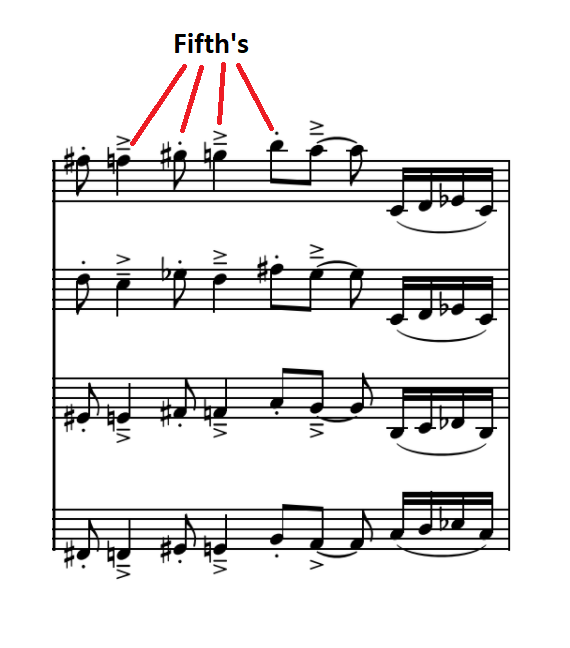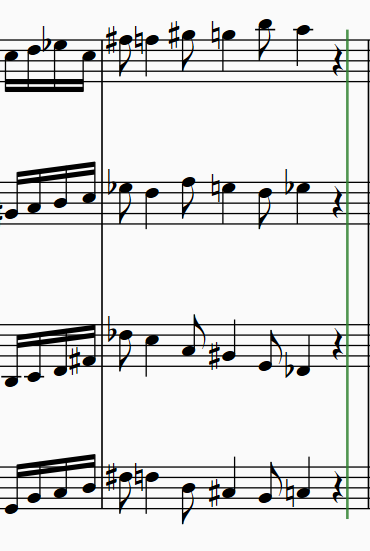Leaderboard
Popular Content
Showing content with the highest reputation on 03/25/2021 in all areas
-
2 points
-
Good evening everyone! I'm ready to present a new piece I have been working on for the last couple of months or so: Adagio for Orchestra. It’s a relatively short piece, not as large in scope as some of my other works I have posted here. Admittedly I’ve had a little bit of writer’s block recently, so I toned things back quite a bit and instead focused on simple themes and experimenting with an expanded orchestra, including Euphonium and Saxophone with the usual instruments. I'm interested in any and all constructive feedback. I had a few goals in mind as I composed this, feel free to chime in on how well I accomplished them: Focus on simple, memorable themes. Experiment with orchestration, using auxiliary instruments to create some unique textures. Integrate Euphonium and Saxophone with the rest of the orchestra. Write something that would work as a middle movement of a larger work, such as a symphony. The piece is loosely structured in a binary form with repeat (ABAB). (0:00 - 1:09) – Introduction. Euphonium solo that is passed between and elaborated by other members of the winds, punctuated by sweeping string lines. Most of the thematic material from the piece is extracted from this opening solo. (1:09 – 2:41) – A Theme. A melancholy dirge carried by a bell-like ostinato played by harp, celesta, and piano, with rustling tremolo in the strings and an eerie chant in the winds. (2:41 – 5:00) – B Theme. A floating theme first presented by the oboe then embellished by the strings to the first big outburst of the piece. Material from the A Theme is elaborated here, then the strings carry the oboe theme to a new momentary high, before settling back into the recap. (5:00 – 7:11) – A Theme recap. The dirge returns, this time building to a euphoric climax, then drifting away into the upper register of the woodwinds and strings. (7:11 – 8:13) – B Theme recap. This time the clarinet sings the theme. I experimented with some polytonality/polymodality/whatever-you-want-to-call-it with the chords in the horns, trumpets, flutes, keyboards, and harp. I’m curious how well I pulled this off. (8:13 – 8:38) – Coda. Return of the Euphonium solo, this time drifting off into silence to end the piece. As usual, I have few specific questions I would like specific feedback on. Feel free to answer as many or as few as you wish: What effect does the music have on you? Does in conjure up an image? Or an emotional feeling? Does it tell you a story? This can be the piece as a whole, or a specific part or parts. What was your favorite part? What was your least favorite part? Do you have any comments or critiques on technique, e.g. harmony, melody writing, counterpoint, orchestration, voice-leading, etc.? How do you feel about the overall form? Is it effective? How well do you think the euphonium and saxophone are integrated with the rest of the orchestra? How do you feel about the harmony in the B theme recap (the nondiatonic chords against the melody in the clarinet)? Is it effective? Do you have any comments of the quality of the performance in the audio file? I really want this to be a decent representation of how the piece would sound if it were performed live, since it is unlikely it ever will be. Feel free to put your "conductor hat" on and critique the "orchestra". I have included a score and welcome any constructive feedback on its presentation. And if you're like me it's a lot more fun to follow along with the score. Are there any composers this reminds you of, that I might enjoy listening to? Sound libraries: Spitfire Symphonic Orchestra and Spitfire Percussion VSL – Eb clarinet, Bass clarinet (in the intro only), Alto sax, Bassoon (for the solo only), Bb Trumpet (for the solos only, and some reinforcement in louder sections), Euphonium, Piano Thanks for listening, I hope you enjoy! If you liked something I did and want me to explain how I did it, feel free to ask as well. -gmm1 point
-
This is something I think about a lot. If you aren't making physical copies of your music, I think you really should. Not just in burning CDs or whatever, but also in notation (and MIDI) so that the music can be re-created in the future if you lose the recordings. It has been noted in the 21st Century, that future generations will likely have no photographs of us, because no one develops physical photographs anymore. Facebook and Instagram are already no longer the monolithic media platforms they once were, as "alternative" platforms like Gab, Bit Chute, etc. are seeing record growth. In short: Facebook and Instagram will probably not be around in the future. But this is where, alongside SIM cards, where the bulk of the photos we take now are. What this means is that, in the future, your grandkids may not be able to find a single photo of you from your adult life. The SIM cards are long gone; the websites either offline or passwords to accounts long forgotten. The same is true of a great deal of music written over the last 40 years, at least. It's all digital. Many, many songs that people have written (especially over the last 15 years) exist entirely in cyberspace. It only exists as "backups" on HDDs which can and will eventually fail, on Box or Mediafire accounts that won't be around eternally, and no physical transcriptions of it exist. What this also means for us is that, you could be this really great musician and composer, but in 60 years? Your descendants may be completely unable to hear anything you ever made, over the course of your entire life. As if you never existed at all. Burn CDs, make cassettes, make sheet music, and many copies of it.1 point
-
yep, sure does. i have not thought about this sort of process in any great detail but I know or seem to know that many composers do this type of thing with varying degrees of awareness. done well and this type of motivic development can result in similar but different passages throughout a piece and give it a cohesiveness that is either explicitly felt or subconsciously noticed. hey, maybe anyone and everyone who does this sort of thing could form a club called "Beethoven's-Be-Us", this appellation a tribute to that master of motivic development, good old Ludwig Van as that guy from A Clockwork Orange called him. regarding the inversions, that is a method that might stretch the similar but different idea to a point where it isn't at all usually explicitly noticed but obviously that is ok. i have a Novation Launchpad which is often, I think, used by dance DJs to fire off various beats, songs, what have you with the push of a button on the pad. I have long entertained the idea of taking a given them, putting it onto a track and then create inversions, diminutions, retrogrades, etc. and fire them off on the fly but not only as individual melodic lines but instead also firing off things simultaneously in the context of invertible counterpoint. But as usual, I don't seem to have enough time for that. (one thing i also have apparently not had time for is to learn that the proper term is diminutions and not dimunitions; i have always thought of it as the latter when apparently it is the former. dim-min-yoo-shyuns, dim-min-yoo-shyuns...it just don't sound right!) the usage of motive C as little grace note ornaments: did you consider whether or not they would be explicitly noticed or not? as far as planning out a movement (which you described to me elsewhere, I believe) the only thing i have tried in that regard is when writing a fugue: i always hope to be able to work in a stretto passage or two. sometimes you want all stretto entries to follow identical interval sequences but sometimes that isn't possible due to undesirable harmonic clashes so you need to make modifications leading to another similar but different scenario and perhaps sometimes more interesting than exact intervals. gmm, thanks for laying out one of your plans of attack, i may have to try it one day in a piece if ever i have enough time.1 point
-
I am glad you liked it @PeterthePapercomPoser! I was really not expecting a new comment in the first post I ever submitted in the forum. I remember back then I was taking a beginners udemy videogame music course. The first assigment (and the only one that I did 😆) was to compose a repeatable simple 10 bars "main town theme" for an imaginary videogame. That is how the Ionian main theme was composed. Since back then I did not know much about scales or modes, I came up with the idea of studying them while composing a similar theme for each mode. I wanted the original Ionian theme to start and finish the piece so I though the "heroic" Lydian might be a nice bridge between the darker Phrygian theme and the Ionian final theme reprise. But now that I listened to it again, you are right that the contrast between the Phrygian and the Lydian mode is quite harsh. It was also my last piece with a DAW (the other one was a piece for strings based on a theme from a Bhrams symphony. I liked it but I never posted it here because of the more than obvious rip-off from Bhrams' original piece). I stopped using a DAW because I would spend more time in the DAW than composing and learning music. Now that I relistened to those two pieces it surprises me how realistic they sound (much more than noteperformer). Now I kinda want to turn all the compositions I made since then into a more realistic sound with virtual instruments and a DAW, but it is so much work... 😅. Thank you for commenting!1 point
-
1 point
-
You would have to modify the first violin melody, since the G natural is not in the particular transposition of the octatonic scale you used. I just kept that the same between my version and the original since I assumed that was the melody. If you modified that to an F#, it should be pretty straight forward to come up with parts that are all in the scale, since there are so many thirds available. Something that I have found works for me with the octatonic scale - try to approach any tritones by contrary motion. Sometimes they sound ok if approached by similar motion, but contrary motion will help the parts sound more independent, at least in my experience. Ultimately your ear is your guide...1 point
-
1 point
-
This is really cool. If this was merely an experiment with octatonic scales I would say it is a success. One thing that jumped out to my ear: in the second bar you use a lot of parallel fifths (see below). One of the special things about the octatonic scale is all of the rich harmonies you can create with all of the third's available. Having this many fifths in a row makes it sound a little stale, at least to me. What you might consider is raising the second violin by a scale degree so it moves in thirds with the first. You also might consider having the viola and cello play a line contrary to the violins, instead of having them in octaves with the first violin. To me this would maintain the octatonic feel much better. Below is an example I whipped up real quick: If the parallel fifth's are to your liking feel free to ignore, just my thoughts. If you want to hear a masterful use of octatonic scale, I'd recommend the opening of the Firebird by Stravinsky. The way he makes use of the major and minor thirds available in the scale, and how he seamlessly shifts between different transpositions of the mode, is remarkable to say the least. Thanks for sharing!1 point
-
Hey! This is pretty cool! I love the new color that each variation introduces when the different modes are used - my favorite was the phrygian which I think should have been last since it's the darkest (also you could have started with lydian since it's considered the brightest). Really cool way to familiarize yourself with the modes - and the result was still quite musical! Flute and Harp are always a good combination imo! Thanks for sharing!1 point






.thumb.png.8b5b433a341551e913a34392660bc95b.png)